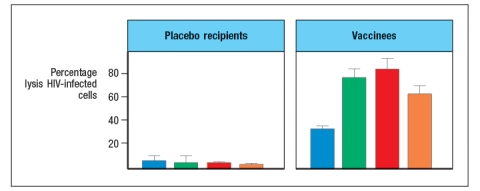Multiple Choice
One HIV vaccine trial provided some small measure of hope for the development of an effective HIV vaccine. This vaccine, known as RV144, was administered to a high risk population in Thailand, and reduced new infections by ~30%. To address the mechanism of immune protection correlating with vaccine efficacy, a series of studies were performed. In one study, total IgG antibodies from four non-infected vaccinees were isolated and were mixed with HIV-infected cells plus peripheral blood lymphocytes from healthy unrelated donors. As a control, IgG antibodies were purified from four donors receiving the placebo, rather than the RV144 vaccine. Six hours later, lysis of the HIV-infected target cells was assessed, as shown in Figure Q40) .  Figure Q40) The immune mechanism that correlates with protection based on these data is:
Figure Q40) The immune mechanism that correlates with protection based on these data is:
A) CD8-dependent target cell lysis
B) Complement-dependent cell lysis
C) Induction of apoptosis by TNF-R stimulation
D) Target cell apoptosis induced by Fas-ligand stimulation
E) ADCC induced by NK cells
Correct Answer:

Verified
Correct Answer:
Verified
Q9: Antiretroviral drugs are effective at blocking HIV
Q10: A small group of HIV-infected individuals
Q11: In the case of HIV infection by
Q12: Unlike defects in antibodies or T cell
Q13: One group of immune deficiency diseases
Q15: A mutant mouse line (Mutant-X) is discovered
Q16: Evidence indicates that HIV-1 and HIV-2 originated
Q17: Individuals that lack all T cells have
Q18: Studies have shown that secondary lymphoid tissues
Q19: Malaria is caused by protozoan parasites, Plasmodium